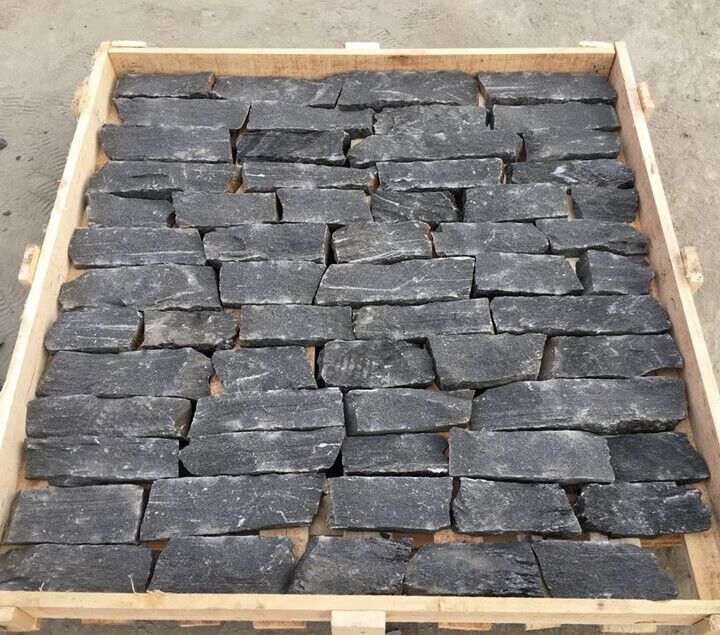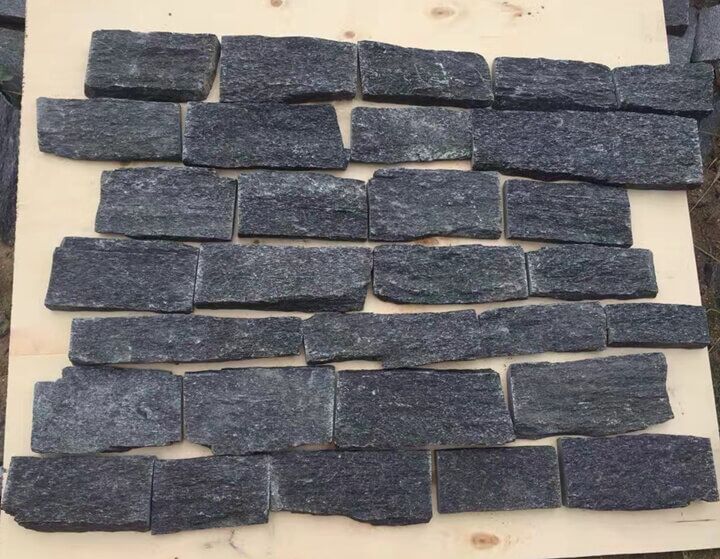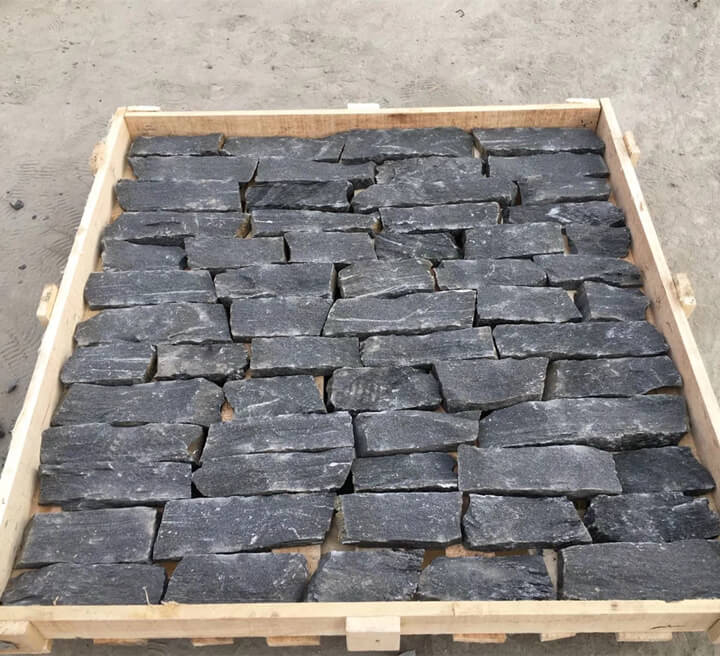Black Quartzite Dry Stack Ledgestone is a natural stone veneer made from hard, weather‑resistant quartzite selected for strength, color stability, and density. Each piece has a split‑face texture that creates strong shadows and visual depth, with tight joints that give the classic dry‑stacked ledgestone appearance without visible grout lines. The back is sawn to a consistent thickness so installers can achieve a flat, secure bond to the substrate with standard stone veneer setting materials.
Panels or loose pieces are typically supplied in modular formats such as 6 in x 24 in ledger panels or calibrated loose ledgestone pieces that fit together in a tight pattern. Corner units and returns are available to wrap columns, inside and outside corners, and wall ends for a finished, monolithic stone look. The natural quartzite composition provides high compressive strength, good freeze‑thaw resistance, and low water absorption, making this product suitable for demanding climates and high‑visibility applications.
The Core B2B Value Proposition
For distributors and dealers, Black Quartzite Dry Stack Ledgestone offers a premium, high‑margin natural stone product with consistent modular sizing that is easy to position against both loose dry stack stone and panelized systems. The deep black quartzite color fills a key demand segment for charcoal and midnight tones that pair with contemporary architecture, dark window systems, and modern exterior palettes.
Compared to generic stacked stone, this product focuses on calibrated thickness, consistent panel sizes, and strong corner solutions, which simplify inventory planning and reduce complaints related to fit and field cutting. The durable quartzite base and split‑face finish give your customers a long‑lasting cladding option that performs across climates, lowering call‑backs and warranty risk.
For architects, designers, and builders, Black Quartzite Dry Stack Ledgestone provides a predictable, repeatable look backed by technical data, packaging clarity, and factory support. It delivers authentic natural stone texture and color while offering the installation efficiency of modular panels or calibrated loose pieces, which supports tight project schedules and bid competitiveness.
Application Showcase
Black quartzite dry stack ledgestone is ideal for exterior facades and feature walls where designers want a sleek, modern black stone envelope with strong linear texture. It is widely used on residential and commercial fronts, garden and retaining walls, and architectural elements such as chimneys and columns.
Indoors, this ledgestone creates dramatic fireplace surrounds, media walls, reception walls, and bar fronts, pairing well with glass, metal, wood, and concrete. Designers also specify it for kitchen backsplashes, island bases, and accent walls where a bold charcoal or midnight black tone is part of the design concept. In hospitality and retail, the stone’s deep color and texture elevate lobbies, spa walls, and focal areas while standing up to traffic and wear on vertical surfaces.
Because of its durable quartzite composition and split‑face texture, Black Quartzite Dry Stack Ledgestone performs very well in outdoor environments such as outdoor kitchens, BBQ surrounds, planter walls, water features, and pool surrounds (where local guidance and sealing practices are followed). For some quartzite products, exposure to constant water can highlight natural iron content, so designers should follow best practices for sealers and placement in wet zones.
Package Method
Black quartzite ledgestone veneer ships in strong, export‑grade wooden crates or cartons designed for forklift handling and safe transport to distributor yards and job sites. Flats are packed in layered courses with cardboard or foam separators to protect split‑face surfaces and sawn backs during transit, and crate labels show color, material, size, batch, and square footage.
Standard panel configurations often include 6 in x 24 in stacked stone panels, with each box or crate containing a fixed number of pieces and a defined coverage per box (for example, 6–8 panels per box with approximately 7–8 square feet of coverage). Loose ledgestone formats are supplied as mixed lengths in calibrated thickness, with packaging based on square feet of flats and lineal feet of corners. Corners are packed separately from flats, often as “L‑shaped” or cut‑back units measured in lineal feet, so contractors can estimate wraps and transitions accurately.
Export pallets are banded and wrapped with moisture‑resistant film to reduce dust and movement in transit. For large B2B orders, mixed‑color or mixed‑format pallets (flats and corners) can be assembled to match project schedules, which helps distributors and contractors stage phases without over‑ordering single formats.
Technical & Logistics Specifications
Black quartzite belongs to the quartzite and quartz‑rich sedimentary stone family, known for high density, abrasion resistance, and strong performance in freeze‑thaw cycles. Typical panel thickness ranges from about 0.5 in to 1.5 in, depending on product line, with most split‑face ledger panels falling between 0.75 in and 1.5 in in total thickness. Height and length are usually set at 6 in x 24 in for modular panels, with some lines offering 4.5 in x 16 in or other modular dimensions.
The surface finish is split face, giving a rugged texture and strong linear shadow effect ideal for dry stack applications. Shade variation is often rated at a higher level (for example, V3–V4) when the product includes multiple charcoal and black tones, so designers can expect some natural movement and variation across the wall. The product is for wall use only and is not intended for horizontal traffic surfaces.
Each box or crate lists pieces per box, square feet per box, and weight per box or crate so logistics teams can plan freight, pallet counts, and handling equipment. Typical boxes of natural stacked stone panels weigh in the 40–60 lb range, while full crates may hold 80–100 square feet of flats or 60–70 lineal feet of corners. Lead times for regular colors are usually short when stock is held in regional warehouses, with container‑based programs available for volume customers and custom projects.
Installation Benefits for Contractors
Black Quartzite Dry Stack Ledgestone is designed to reduce labor hours compared to old‑style, fully random loose stone walls. Modular ledger panels or pre‑sized loose ledgestone pieces speed layout and fitting, letting masons cover more wall area per day while still delivering a true dry stack look.
The sawn backs give a predictable contact surface for mortar, thinset, or stone veneer adhesive systems approved by local codes. Tight joints between pieces reduce pointing time and eliminate the need for visible grout joints on the face, which many clients prefer for modern, linear designs. Dedicated corner pieces remove much of the complex on‑site mitering and reduce waste from cutting full panels to wrap edges, which lowers both material loss and labor time.
Because quartzite is hard and dense, cutting is best done with diamond blades rated for stone, but the consistent thickness and modular sizes help offset the extra saw time compared to softer stones. Clear packaging labels and format separation between flats and corners make staging on site simple, and panelized formats also support installation by crews with a range of experience levels, not only master masons.
Manufacturing & Quality Control
Black Quartzite Dry Stack Ledgestone starts with block or slab selection in the quarry, where black and charcoal quartzite with stable structure and consistent veining is chosen for processing. Blocks are sawn into strips, then split on the face to create the ledgestone texture while the back is cut flat to meet targeted thickness tolerances.
In panelized lines, individual ledgestone strips are hand‑assembled and bonded into panels such as 6 in x 24 in modules, with tight joints and interlocking edges designed to hide seams on the wall. Corners are produced as L‑shaped or cut‑back elements, which can include returns that finish the look of a full‑bed stone wall in a thin veneer format.
Quality control checkpoints monitor thickness range, face texture, color consistency by batch, bond strength of assembled panels, and dimensional tolerances for both flats and corners. Packaging inspections confirm correct labeling, count, and crate integrity before shipment, supporting importers and distributors who rely on accurate paperwork and predictable material for inventory and project planning.



